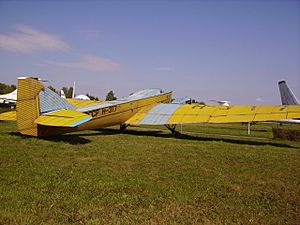Tupolev TB-1 facts for kids
The Tupolev TB-1 was a very important airplane built in the Soviet Union (which is now mostly Russia) a long time ago. It was also known as ANT-4. This plane was special because it was one of the first big, all-metal bomber aircraft ever made. It helped the Soviet Union become a strong country in aviation.
Contents
The Tupolev TB-1: A Pioneer of Soviet Aviation
Building a Giant
The Tupolev TB-1 was designed by a famous engineer named Andrei Tupolev. His team started working on it in 1925. It was a huge step forward because it was one of the first large airplanes made almost entirely of metal. Before this, many planes were built using wood and fabric. Using metal made the plane much stronger and more durable.
The first flight of the TB-1 happened on November 26, 1925. It was a big moment for Soviet aviation. After successful tests, the plane started being built in factories in 1929. It quickly became the main heavy bomber for the Soviet Air Force.
What Made It Special?
The TB-1 was a twin-engine plane, meaning it had two powerful engines to help it fly. It could carry a lot of bombs, making it a true "heavy bomber" for its time. Its strong metal design also meant it could fly in different weather conditions.
Besides dropping bombs, the TB-1 was very versatile. It could be used for many other jobs:
- Transport: It carried cargo and supplies to far-off places.
- Reconnaissance: It flew over areas to gather information.
- Torpedo Bomber: Some versions could carry torpedoes to attack ships.
- Paratrooper Transport: It could drop soldiers with parachutes.
Amazing Flights and Experiments
The Tupolev TB-1 was known for some incredible long-distance flights. One famous plane, named Strana Sovyetov (meaning "Land of the Soviets"), flew from Moscow to New York in 1929. This showed how reliable and capable the TB-1 was. It was a huge achievement for aviation at the time.
The TB-1 was also part of some very interesting experiments called "Zveno" (meaning "link" or "flight" in Russian). In these tests, a TB-1 would carry smaller fighter planes under its wings. The idea was that the smaller fighters could launch from the larger bomber in mid-air. This was a very early idea for what we now call "parasite fighters." It showed how creative engineers were trying to make planes more effective in battle.
End of an Era
The Tupolev TB-1 served the Soviet Union for many years. It was a key part of their air force in the 1930s. However, as technology advanced, newer and faster bombers were developed. The TB-1 slowly started to be replaced by more modern aircraft, like the Tupolev TB-3.
Even though it was eventually retired from combat roles, many TB-1s continued to be used for transport and other non-military tasks for a long time. Its legacy as one of the first successful all-metal heavy bombers is still remembered today. It helped lay the groundwork for future large aircraft designs.
Images for kids
See also
 In Spanish: Túpolev TB-1 para niños
In Spanish: Túpolev TB-1 para niños




